Round Effects: Tasg-D1 is Responsible for Grain Shape in Indian Dwarf Wheat
Wheat (Triticum spp.), one of the oldest cultivated cereals, is a major food crop grown in many regions with temperate climates. At present, wheat is grown over a wider area than any other commercial crop. Given its importance, extensive marker-assisted breeding of wheat varieties has been undertaken to improve the quality and reliability of cultivated wheat but requires the isolation of genetic elements responsible for phenotypes of interest. Due to multiple ploidy events that occurred during domestication and improvement, the subgenomes of hexaploid (AABBDD) wheat spp. can be challenging to map. Triticum sphaerococcum (Perc.), also known as Indian dwarf wheat, is endemic to India and Pakistan, and is distinguished from other cultivated wheat subspecies by the fact that it produces round grains. Historically, wheat crosses were used to locate the s gene thought to be responsible for grain roundness (Sears, 1947; Salina et al., 2000); however, to date, the exact location and function of this gene has remained unknown.
Cheng et al. (2020) used positional cloning to identify and functionally characterize a gene linked to grain shape, designated Tasg-D1, near the centromere of chromosome 3 of the T. sphaerococcum Perc. D genome. Importantly, this site was marked by previous studies as a probable location of the s gene responsible for the round-grain phenotype (Sears, 1947, Singh, 1987). These early analyses used inheritance analyses to predict that the hypothetical s gene is incompletely dominant, and the authors confirmed this prediction by examining the segregation ratio of grain shape using the offspring of a residual heterozygous line generated by a common wheat HS2 (a large-grained wheat cultivar) and T. sphaerococcum. The authors noted that Tasg-D1 expression was pleiotropic, affecting plant morphological traits (including plant height and spikelet morphology) as well as grain shape and thousand-grain weight. This result makes sense because Tasg-D1 was found to downregulate brassinosteroid (BR) signaling. In seeds, BR-deficient mutations have been linked to short cell length in seed tissue, resulting in rounder, less elongated grain (Jiang and Lin, 2013). However, BRs are also known to regulate many other physiological processes, including those responsible for the pleiotropic phenotypes observed here (Zhu et al., 2013).
Functional characterization revealed that Tasg-D1 was a serine/threonine protein kinase glycogen synthase kinase 3 (GSK-3) containing a distinctive TREE (Thr-283-Arg-284-Glu-285-Glu-286) domain. GSK-3s are known to inhibit downstream targets by facilitating the phosphorylation of serine and threonine residues. In addition, TREE domains are highly conserved across flowering plants, and their phosphorylation is an important step in BR signalling pathways (Choe et al., 2002). A previous study in rice showed that overexpression of a GSK protein with a mutated TREE domain disrupted seed elongation, causing plants to produce round grains (Tong et al., 2012).
The authors then tested whether the round grain phenotype was caused by a similar mechanism in T. sphaerococcum by obtaining premature termination mutants for the TaSG-D1 haplotype from the ND4332 line. Plants homozygous for the premature termination mutation were taller, had longer spike length, and showed longer grains than wild-type plants. A similar analysis of a TaSG-A1 homeolog with a mutation in the TREE domain showed that this gene may also be implicated in grain shape. The authors also overexpressed the coding sequence of the HS2 and ND4332 Tasg-D1 alleles under the control of the Ubiquitin promotor in Fielder wheat. Analysis of the resulting plant and grain morphology revealed that lines containing OE-TaSG-D1 (cloned from HS2) showed longer grains than control plants, while lines containing OE-Tasg-D1 (cloned from ND4332) showed shorter, rounder grains (see Figure). Comparisons of NILs revealed that NIL-Tasg-D1 plants were less sensitive to exogenous BR than NIL-TaSG-D1 plants, and showed only marginal root lengthening when exposed to BR concentrations as high as 0.1μM. OE-Tasg-D1 plants also showed delayed flowering, shorter plant and spikelet height, and lower thousand-grain weight than control plants. Finally, electron micrographs of the grain pericarp revealed that cell elongation was lower in ND4332 plants than in HS2 plants. Taken together, these results indicate that Tasg-D1 negatively regulates cell elongation, thereby causing both the round grain phenotype and several other pleiotropic effects.
The implications of this paper are twofold: first, the authors have identified Tasg-D1, a gene encoding a GSK-3 protein that negatively regulates cell elongation via BR signalling, as the s gene responsible for the round seed shape found in T. sphaerococcum. From a phylogenetic analysis of the TREE domains of TaSG-D1 genes from 898 wheat accessions, the low-elongation allele found in T. sphaerococcum (and its associated phenotypic effects) likely arose via spontaneous mutation from T. aestivum after hexaploidization. Second, the authors found that given the same thousand-grain weight, the flour extraction rate from semispherical grain from ND4332 plants was higher than it was from the more elongated grain of HS2 plants. Given this difference, the identification of Tasg-D1 as the gene responsible for the round-grain phenotype may permit the future breeding or genetic engineering of round-grained wheat cultivars that better optimize wheat productivity by enhancing flour extraction rate.
P. William Hughes
Department of Ecology, Environment, and Plant Sciences, Stockholm University, Svante Arrhenius väg 20, 10405 Stockholm, SE
ORCID: 0000-0003-4142-2579
REFERENCES
Cheng, X., Xin, M., Xu, R., Chen, Z., Cai, W., Chai, L., Xu, H., Guo, W., Ni, Z., and Sun, Q. (2020). A single amino acid substitution in STKe_GSK3 kinase conferring semispherical grains and its implications for the origin of Triticum sphaerococcum Perc. Plant Cell https://doi.org/10.1105/tpc.19.00580.
Choe, S., Schmitz., R., Fujioka, S., Takatsuto, S., Lee, M., Yoshida, S., Feldmann, K., and Tax, F. (2002). Arabidopsis brassinosteroid-insensitive dwarf12 mutants are semidominant and defective in a glycogen synthase kinase 3β-like kinase. Plant Physiol. 130: 1506-1515
Jiang, W. and Lin, W. (2013). Brassinosteroid functions in Arabidopsis seed development. Plant Signal Behav. 8: e25928
Salina, E., Borner, A., Leonova, I., Korzun, V., Laikova, L., Maystrenko, O., and Roder, M. (2000). Microsatellite mapping of the induced sphaerococcoid mutation genes in Triticum aestivum. Theor. Appl. Genet. 100: 686-689.
Sears, E. (1947). The sphaerococcum gene in wheat. Genetics. 32: 102-103.
Singh, D. (1987). Mapping of the complex T. sphaerococcum locus. Wheat Information Service 64: 17-20.
Tong, H., Liu, L., Jin, Y., Du, L., Yin, Y., Qian, Q., Zhu, L., and Chu, C. (2012). DWARF AND LOW TILLERING acts as a direct downstream target of a GSK-3/SHAGGY-like kinase to mediate brassinosteroid responses in rice. Plant Cell. 24: 1562-2577.
Zhu, J., Sae-Seaw, J., and Wang, Z. (2013). Brassinosteroid signalling. Development 140: 1615-1620.




